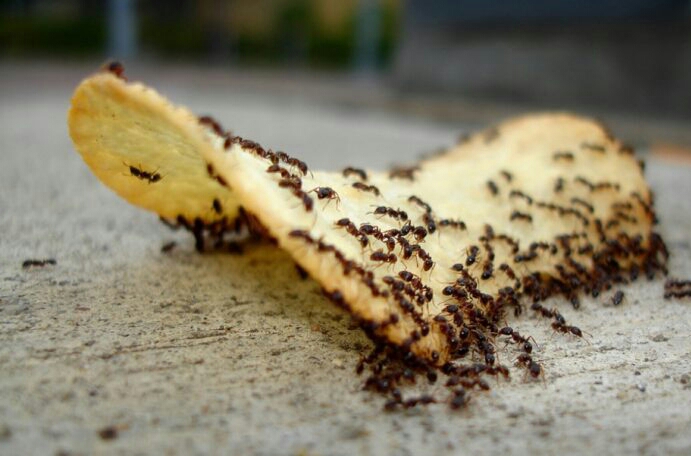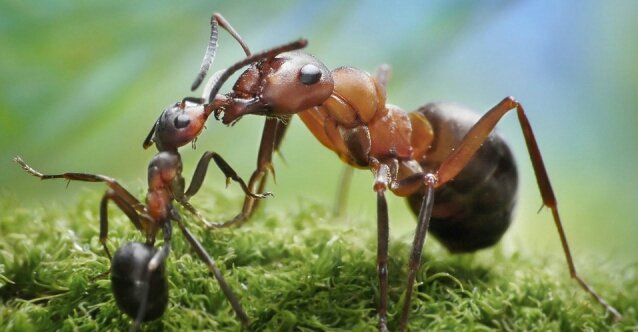
Ants are insects of the members of Formicidae, the Hymenoptera. Ants have more than 12,000 species (species), mostly live in the area of astronomy. Most of the ants are known as social insects, with colonies and their regular nests consisting of thousands of ants per colony. Members of the colony are divided into worker ants, male ants, and queen ants. There may also be a group of guard ants. One colony can dominate a large area to support their lives. Ant colonies are sometimes called "superorganisms" because of their colonies that form a unity.

Despite its relatively small size, the ants are among the strongest animals in the world. Male ants are able to sustain loads weighing fifty times their own body weight, comparable to elephants that are only able to sustain loads weighing twice the weight of their own body. Ants are rivaled only by rhinoceros beetles capable of sustaining loads weighing 850 times their own body weight.
Formic acid is also called "acid ant" because the ants produce this acid as a self-defense tool.
Type and spread
Ants have controlled almost all parts of the earth on Earth. Only in some places like Iceland, Greenland, and Hawaiian, they do not control the area. As their numbers increase, they can membinuk about 15-20% of the amount of biomass of large animals.
Some types of ants are well known to humans for living together with humans, such as black ants, big ants, red ants, fire ants, and grasses.
Termites are sometimes called white ants but are completely different groups of ants even though they have the same social structure.
Evolution
The Formicidae family is part of the Hymenoptera order, which includes bees and wasps. Ants are descendants of the Vespoidea wasp generation. The phylogenetic analysis indicates that ants have evolved from the vespoid dragonflies in the Cretaceous period around 120 million to 170 million years ago. After the emergence of Angiosperms around 100 million years ago, they diversified the influence of ecolysis some 60 million years ago. Some of the Cretaceous period is the mid form of ants and wasps, and this adds evidence to the wasp's ancestors. Like other Hymenoptera dwarf animals, the ant genetic system is found to be dihaplodiploidy.
In 1966, E. O. Wilson, et al. found ant fossils in tree sap (Sphecomyrma freyi) from the Cretaceous period. The fossil is trapped in a tree sap in New Jersey and has been over 80 million years old. This fossil provides the clearest evidence of the relationship between modern ants and non-social wasps. Kapur period ants share the characteristics of modern ants and wasps.
During the Cretaceous period, only a handful of species survived the large continent of Laurasia (northern part). They are also very rare with a ratio of about 1% of other insects. Ants become dominant after adaptive radiation at the beginning of the Tertiary Period. The number of species remaining in the Cretaceous and Ecocene periods, only 1 in 10 genera extinct to date. 56% of the ant genera are present in fossil wood sap in the Baltic region (since the early Oligocene), and about 96% of the ant genera found in the Dominican sap fossil (since the early Miocene) still survive today.
Morphology
The body of the ant consists of three parts, namely the head, mesosoma (chest), and metasoma (stomach). The morphology of ants is quite clear compared to other insects that also have antennas, metapleural glands, and the second abdominal section associated to the stalk of ants forming a narrow waist (pedunkel) between the mesosoma (the portion of the chest cavity and the abdominal area) and the metasoma (abdomen less abdominal segment in a petiole). Petioles that can be formed by one or two nodes (only the second, or second and third abdominal segments can be realized).
At the head of the ant there are many sensory organs. Ants, like other insects, have compound eyes consisting of a smaller collection of lenses and incorporated to detect motion very well. They also have threeoselus at the top of their heads to detect light changes and polarization. Most ants generally have poor vision, even some of them are blind. However, some ant species, such as the Australian bulldog ants, have good eyesight. On its head there is also a pair of antennas that help the ants detect chemical stimuli. Antenna ants are also used to communicate with each other and detect pheromones released by other ants. In addition, ant antennas are also useful as a touch tool to detect everything that is in front of it. At the front of the ant head there is also a pair of jaws or mandibles used to carry food, manipulate objects, build nests, and for defense. In some species, inside the mouth there is a small sac to store food for a while before being transferred to another ant or larva.
In the ant chest there are three pairs of legs and at the end of each foot there is a small claw that helps it climb and stand on the surface. Most male and female ants of the queen have wings. However, after the mating females will shed its wings and become the queen of ants that are not winged. Workers ants and warriors have no wings.
In the metasoma (stomach) of the ant there are many important internal organs, including reproductive organs. Some ant species also have a sting connected to some sort of toxic gland to paralyze the prey and protect its nest. An ant species like Formica yessensis has an ant-acid-producing gland that can be sprayed towards the enemy for defense.
The life of an ant starts from an egg. If the egg has been fertilized, the ants are hatched females (diploid); if not males (haploid). Ants are holometabolism, which grows through a complete metamorphosis, passing through the larval and pupa stage (with an exarate pupa) before they mature. The larval stage is a very vulnerable stage - more clearly the ant larva has no legs at all - and can not take care of itself.
The difference between queen and worker (where both females), and between kastapekerja if any, is determined at the time of feeding while still being a larva. Food is fed to larvae by a process called trophallaxis where an ant regurgitates food previously stored in crop for communal storage. This is also the way adult ants use to distribute food to other adult ants. Larva and pupa should be stored at a constant enough temperature to ensure they grow well, so they are often transferred to various brood chambers in the colony.
An ant worker who just entered adulthood spent their first few days to care for the queen and young ants. After that it increases into digging and other nest work, and then foraging and maintaining the nest. This change of duty can occur suddenly and is called a temporary caste. A theory of why it is because of foraging has a high risk of death, so ants only participate if they are old enough and somehow closer to death.bold
Please vote me to improve...
Downvoting a post can decrease pending rewards and make it less visible. Common reasons:
Submit
Oc
Downvoting a post can decrease pending rewards and make it less visible. Common reasons:
Submit
Good vision and views...keep it up
Downvoting a post can decrease pending rewards and make it less visible. Common reasons:
Submit
Thank
Downvoting a post can decrease pending rewards and make it less visible. Common reasons:
Submit
This post received a 3.64% upvote from @randowhale thanks to @miftarizal! To learn more, check out @randowhale 101 - Everything You Need to Know!
Downvoting a post can decrease pending rewards and make it less visible. Common reasons:
Submit
Thanks you @randowhale
Downvoting a post can decrease pending rewards and make it less visible. Common reasons:
Submit